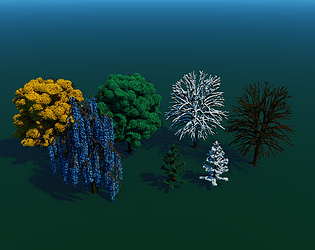This is surprisingly tense.
MountainLabs
Creator of
Recent community posts
It is also strange that you say you think it is the ray origins and diretions that are not calculated correctly, (although you could very possibly be right, I wouldn't doubt it) But it is strange, because if I do a basic ray box intersection using the same ray directions and origins there is no warping at all. The warping exists entirely within the DDA algorithm I have. Here it is:
fn Sphere_DDA_March(
start_pos: vec3<f32>, // Starting position of the ray in world space
end_pos: vec3<f32>, // Ending position of the ray in world space
voxel_size: vec3<f32>, // Size of each voxel in the voxel grid
bounds: vec3<i32>, // Dimensions of the voxel grid (width, height, depth)
) -> vec4<f32> {
var direction: vec3<f32> = normalize(vec3<f32>(end_pos - start_pos));
var step: vec3<i32> = vec3<i32>(
select(-1, 1, direction.x > 0.0),
select(-1, 1, direction.y > 0.0),
select(-1, 1, direction.z > 0.0)
);
var tMax: vec3<f32> = vec3<f32>(
((select(floor(start_pos.x / voxel_size.x) + 1.0, floor(start_pos.x / voxel_size.x), direction.x < 0.0) * voxel_size.x) - start_pos.x) / direction.x,
((select(floor(start_pos.y / voxel_size.y) + 1.0, floor(start_pos.y / voxel_size.y), direction.y < 0.0) * voxel_size.y) - start_pos.y) / direction.y,
((select(floor(start_pos.z / voxel_size.z) + 1.0, floor(start_pos.z / voxel_size.z), direction.z < 0.0) * voxel_size.z) - start_pos.z) / direction.z
);
var tDelta: vec3<f32> = vec3<f32>(
abs(voxel_size.x / direction.x),
abs(voxel_size.y / direction.y),
abs(voxel_size.z / direction.z)
);
let center: vec3<f32> = vec3<f32>(15.0);
var ray_world_coord = vec3<f32>(vec3<f32>(current_voxel) * voxel_size);
var ray_dist: f32 = f32(sqrt(((ray_world_coord.x - camera.position.x) * (ray_world_coord.x - camera.position.x)) + ((ray_world_coord.y - camera.position.y) * (ray_world_coord.y - camera.position.y)) + ((ray_world_coord.z - camera.position.z) * (ray_world_coord.z - camera.position.z))));
while(ray_dist < 256.0){
ray_world_coord = vec3<f32>(vec3<f32>(current_voxel) * voxel_size);
var world_cord = vec3<f32>(vec3<f32>(current_voxel) * voxel_size);
ray_dist = f32(sqrt(((ray_world_coord.x - camera.position.x) * (ray_world_coord.x - camera.position.x)) + ((ray_world_coord.y - camera.position.y) * (ray_world_coord.y - camera.position.y)) + ((ray_world_coord.z - camera.position.z) * (ray_world_coord.z - camera.position.z))));
var dist: f32 = f32(sqrt(((world_cord.x - center.x) * (world_cord.x - center.x)) + ((world_cord.y - center.y) * (world_cord.y - center.y)) + ((world_cord.z - center.z) * (world_cord.z - center.z))));
if (dist < 60.0){
let start_light: vec3<f32> = vec3<f32>(world_cord.x, world_cord.y + -0.5, world_cord.z);
let end_light: vec3<f32> = vec3<f32>(world_cord.x, world_cord.y + 10.0, world_cord.z);
let output = DDA_Light(start_light, end_light, voxel_size, bounds);
if (output == 0) {
return vec4<f32>(1.0, ray_dist / 100.0, 0.0, 1.0);
} else {
return vec4<f32>(0.75, ray_dist / 100.0, 0.0, 1.0);
}
}
if (tMax.x < tMax.y && tMax.x < tMax.z) {
current_voxel.x += step.x;
tMax.x += tDelta.x;
} else if (tMax.y < tMax.z) {
current_voxel.y += step.y;
tMax.y += tDelta.y;
} else {
current_voxel.z += step.z;
tMax.z += tDelta.z;
}
}
return vec4<f32>(0.0);
}
Indeed, If I run into any trouble I will ask :D I think I'll probably do the voxel raytracing first, and just have the meshing later, I'll have the voxel raytracer write to the Depth-Buffer and then just have the rasterizer compare depthbuffer distance and check if it should render that particular pixel or not. But I'll be doing all raytracing in a compute shader which will fill a texture and have that texture be read by the fragment shader later.





